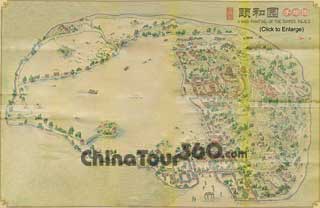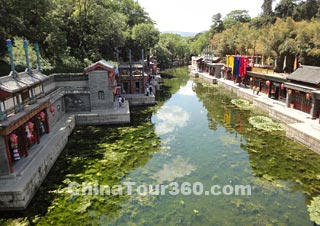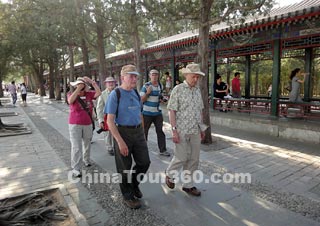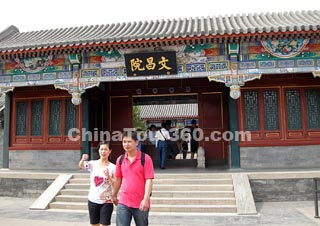Self-guided Summer Palace Tour
"Route from Newly-built Palace Gate"
- Code: SP03
 |
| Summer Palace Map |
To take the Summer Palace tour along this route, you will enter the Summer Palace through the Newly-built Palace Gate. This gate was built in 1809, later than the other two gates, thus got the name.
Walking west after entering the garden, you can see the famous plated Bronze Ox watching warily at Kunming Lake and the Longevity Hill. The Bronze Ox has an important function of water-level monitoring. The foundation of the Bronze Ox is 10 meters higher than the Forbidden City. By monitoring the water here, the supervisor could know the water-level of the city wall around the Forbidden City and took useful measures properly.
At the south side of the Bronze Ox, you can see the Seventeen-Arch Bridge which combines Nanhu Island and Dong Di (East Causeway of Kunming Lake). The Bridge was first built in 1750 in imitation of Lugou Bridge. Being the biggest existing stone bridge, the Seventeen-Arch Bridge has an overall length of 150 meters, width of 8 meters. On top of the bridge are 544 lifelike stone lions with exquisite workmanship.
Walking across the Seventeen-Arch Bridge, you will arrive at Nanhu Island, which occupies an area of ten thousand square meters and is the largest island in Nanhu Lake. The buildings on the island were all rebuilt after being destroyed by the Anglo-French Allied Forces in 1860.
From Nanhu Island, you can take a ferry to the Qingyan Boat (Clear and Peaceful Boat/ Marble Boat). The body of the boat was first built by stone in 1755 and there was wooden Chinese style pavilion on it. The wooden pavilion was burned in 1860 and when it was rebuilt in 1893, it was designed as western style imitating the pattern of French "Soaring Phoenix" yacht. Besides, the pavilion was varnished like the texture of marble, so it looks like a big stone building.
|
|
Plowing and Weaving Scenery Area is situated at northwest of the Qingyan Boat. Usually travelers pay little attention to this quiet place. First built in 1750, it was an area full of charms of a water town, while in 1860, it was razed to the ground by the Anglo-French Allied Forces. Empress Dowager Cixi subsequently built Naval School at this place surreptitiously by diverting the military expenditure. And since then, the Plowing and Weaving Scenery Area lost its feature for several years. In 1998, the government invested much for its reparation and reconstruction, and in 2004, the area started to invite travelers.
Continue your Summer Palace tour and head northeast, you can see Suzhou River after walking across the Stone Bridge. The bustling Suzhou Market Street is along the river bank. During the periods of emperors Kangxi, Yongzheng and Qianlong, the gardens were popular in the capital and there were market streets in the gardens, among which, the most famous and representative ones were Suzhou Market Street in the Summer Palace and Tongleyuan Market Street in the Imperial Garden Yuanmingyuan.
After leaving Suzhou Market Street, walk south to pass the Sea of Wisdom Temple, you will arrive at the Tower of Buddhist Incense. The tower was first built during the period of Emperor Qianlong and it was reported that it cost 780 thousand cent silver for reconstruction during the Emperor Guangxu period after being destroyed in 1860, which has been the most costly project in the Summer Palace. The Tower of Buddhist Incense is located at the top of the Longevity Hill; it is the highest and major architectural item in the Summer Palace and the symbol of it.
The Hall of Dispelling Clouds stands by the south of the Tower of Buddhist Incense. It was rebuilt on its original site in 1887 and was the place where the Empress Dowager Cixi used to celebrate her birthday. The main gate of the Hall is Cloud-Dispelling Gate, which marks the center of the Long Gallery.
The Long Gallery runs through the Gate of Dispelling Clouds. With a length of 728 meters, it is the longest corridor in Chinese classical gardens and has been recorded in the Guinness Book of World Records in 1990 as "the longest art gallery in the world".
|
|
Walking eastward along the Long Gallery to pass the Gate for Greeting the Moon (Yao Yue Men), you will reach the Hall of Joyful Longevity. Here it was Empress Dowager Cixi’s splendid residential place since it was reconstructed in 1887 and it was the first place to be illuminated with electricity in China.
Situated at the southeast of the Hall of Joyful Longevity, the Hall of Virtue and Harmony of the Summer Palace was the place where Empress Dowager Cixi used to watch opera and it has been the best well-preserved extant dramatic stage in China. Empress Dowager Cixi's first portrait drew by an American female painter Carl in 1903 is treasured in the hall.
Your next destination of Summer Palace tour, Yiyun House which means "book collection", is located west of the Hall of Virtue and Harmony. It was first built in 1750, demolished in 1860 and rebuilt in 1886. Yulong, who was crowned as Emperor Guangxu's empress, used to live here. After the victory of the 1911 Revolution, Empress Yulong ordered Puyi to abdicate the throne and hence ended 200 years' dominance of the Qing Dynasty and also it was the end of Chinese feudal dynasties.
Walking south for a few minutes, you will reach the Hall of Jade Ripples, which was the residence of Emperor Guangxu during his stay in the Summer Palace. After the Failure of the Reform Movement in 1898, Empress Guangxu was held here in captivity. During that time, the hall was walled up and looked exactly like a jail. Nowadays, the brick wall has been mostly pulled down and only the wall inside the hall is still there as the testimony of history related to the Reform Movement.
|
|
Continuously heading south along the causeway of Kunming Lake, you can see Wenchang Gallery at the east side of the causeway. Wenchang Gallery is the largest and highest-ranking museum in Chinese ancient gardens. There are six exhibition zones treasuring thousands of rare cultural relics from the Shang and Zhou Dynasties to the Qing Dynasty. The famous "Great Collection of Ancient and Modern Books" is also treasured here, which is the most comprehensive extant encyclopedia in China.
Hall of Benevolence and Longevity is located northeast of Wenchang Gallery within several minutes' walking distance. It was the main hall in the garden, where the Empress Dowager Cixi and Emperor Guangxu administered affairs of state. The sight that first came into your eyes after entering the gate is a big stone in the courtyard, which looks like a God of Longevity and thus got the name "the God of Longevity Stone". In the front of the hall, you will find two big cauldrons. What was the use of the big cauldrons in the courtyard? In ancient China, they were full of water and used for fire protection.
Now you can round off your trip to the Summer Palace with a brief visit to the East Palace Gate. It is a Wudian Roof style construction with five doors. The middle door is especially for emperors and empresses, the next two ones are for nobles and ministers, while the soldiers and eunuchs can only use the side doors.
- More Self-guided Summer Palace Tours:
- Route from North Palace Gate
- Route from East Palace Gate
- Beijing Tours including the visit to Summer Palace:
- Capital Beijing Travel: 4-Day Beijing
- China Highlights: 9-Day Beijing - Xian - Shanghai
- Beijing Impression: 5-Day Small Group Beijing Tour













